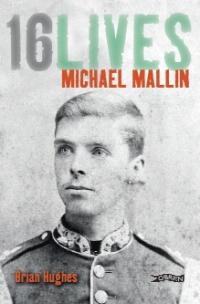16 Lives—Michael Mallin
Published in 20th-century / Contemporary History, Book Reviews, Issue 5 (Sept/Oct 2012), Reviews, Revolutionary Period 1912-23, Volume 20
16 Lives—Michael Mallin
Brian Hughes
(O’Brien Press, €11.99)
ISBN 9781847172662
‘I am a silk weaver by trade and have been employed by the Transport Union as band instructor. During my instruction of these bands they became part of the Citizen Army and from this I was asked to become a drill instructor. I had no commission whatever in the Citizen Army’, declared Michael Mallin, who commanded a garrison in St Stephen’s Green during Easter Week, in his own defence during his field general court martial.As Brian Hughes illustrates in this assured biography, the first on its subject, Mallin was a silk weaver and a band instructor for the ITGWU but the remainder is patently untrue. Poignant letters written on the eve of his execution indicate that Mallin’s attempts to mislead the jury were kindled by remorse (‘I have left my wife and children absolutely destitute’). The author proposes that, in contrast to other 1916 leaders, Mallin viewed his death less as a ‘sacrifice’ than as a punishment and, critically, accepted full responsibility. Executed on the morning of 8 May 1916, Mallin ‘had two priorities in life, and . . . one tragically cost him the other’.Born in a tenement in the Liberties in 1874, Mallin joined the 21st Royal Scots Fusiliers as a drummer boy when he was fourteen. Despite receiving medals for his role in the Tirah campaign in India (where he served for six years), Mallin began to detest the British army. Hughes identifies this period, in which Mallin’s sympathies gradually shift to the natives, as crucial in his burgeoning nationalism. Shortly after becoming a silk weaver (around 1903), Mallin became secretary of the Silk Weavers’ Trade Union. This represents a milestone on his road to socialism. In 1909 Mallin was elected to the unity committee of the Socialist Party of Ireland; in 1913 he was instrumental in securing the demands of Dublin silk weavers during their four-month strike, and by 1915 he was chief-of-staff of the Irish Citizen Army, second in command to James Connolly. When Connolly was co-opted onto the military council of the IRB, Mallin and the Irish Citizen Army inexorably became involved in the Rising. On Easter Monday, Mallin was assigned the rank of commandant (with Countess Markievicz as his deputy) and occupied St Stephen’s Green, where he ordered his men to dig trenches. Pounded by British forces, Mallin’s garrison withdrew to the College of Surgeons (a bullet passed through his hat during the retreat) but the relentless barrage of enemy firepower continued. Bereft of supplies and isolated from rebel headquarters (he was unaware of the leaders’ unconditional surrender), Mallin surrendered, breaking down as he read the order. Criticism of Mallin’s contribution in the Rising revolves around his military tactics and Hughes offers a balanced analysis of the validity of these claims. While all other sites taken by the rebels consisted of large, strategically important buildings, the Green was an open park that left the garrison very vulnerable. Secondly, and more significantly, Mallin failed to occupy—or even attempt to occupy—the Shelbourne Hotel. The author argues that the absence of surviving documents outlining the rebels’ plan for the Rising means that responsibility for the Green débâcle is unclear. Hughes, however, attributes blame to the Dubliner in relation to the Shelbourne Hotel. While the shortage of resources and manpower are cited as mitigating circumstances, Mallin had over thirteen years’ experience in the British army and wrote regular articles in the Workers’ Republic on implementing guerrilla operations but couldn’t apply the theory. The evaluation of Mallin’s individual performance during Easter Week, based on testimonies of those who served under him, is more revealing. The evidence here is ‘entirely positive’; despite his tactical mistakes, Mallin ‘clearly earned the respect and admiration of those he commanded’, and Markievicz later claimed that the faith shown by Mallin (and William Partridge) in the College of Surgeons inspired her conversion to Catholicism.Based on his own MPhil. dissertation, Hughes compellingly portrays a softly spoken music teacher and a dedicated family man with a strong sense of discipline whose commitment to violent insurrection robbed his pregnant wife of a husband and his four young children of a father. Conscientious attention to detail evokes the man and the period. When younger members of the garrison slashed a painting of Queen Victoria in the College of Surgeons, Mallin reprimanded the guilty parties and threatened to shoot anyone who engaged in such vandalism. Later, protesters, aggrieved by the Rising, gathered outside the Coombe hospital when Mallin’s wife, Agnes, gave birth to Maura Constance, 109 days after his execution. Written in an unfussy style, the book is consistent with the publisher’s aim of providing ‘meticulously researched yet accessible’ biographies of the Easter Rising leaders between now and 2016 and rescues Mallin from the long shadows cast by the Proclamation signatories. The author persuasively concludes that Mallin’s muted reputation is due to his inclination to organise rather than to orate and asks whether the labour history of the Rising only allows for two great figures: Connolly and Markievicz. Perhaps Mallin’s farewell letter to his wife (his instructions therein that his son and daughter join the church were later duly fulfilled) also offers a clue to history’s oversight. In urging Agnes to ‘pray for all the souls who fell in this fight Irish & English’, Mallin hints at a complexity incompatible with the rigid criteria for idolisation demanded of the Rising’s heroes. HI
Brendan Daly is a freelance journalist and writer.
















